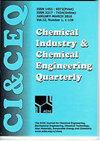Microstructure and fracture mode of unalloyed dual phase austempered ductile iron
IF 0.8
4区 工程技术
Q4 CHEMISTRY, APPLIED
Chemical Industry & Chemical Engineering Quarterly
Pub Date : 2021-01-01
DOI:10.2298/ciceq201222027j
引用次数: 1
Abstract
Dual phase ADI material microstructure consists of different amounts and morphologies of ausferrite and free ferrite, obtained by subjecting ductile iron to specific heat treatment. As such, its strength is lower compared to comparable ADI materials, but exhibiting a higher ductility, the major disadvantage of ADI. In the current study, an unalloyed ductile iron was intercritical austenitised in two-phase regions (?+?) at four temperatures from 840 to 780?C for 2 hours and austempered at 400?C for 1 hour to obtain dual phase ADI with different percentages of free ferrite and ausferrite. Metallographic and fracture studies were performed by light and scanning electron microscopy, respectively. Microscopy results were correlated to tensile testing results. The results indicated that, as the amount of ausferrite present in the matrix increases, higher values of strength and lower ductility are obtained. The fracture surfaces of dual phase ADI microstructures with 22.8% of ausferrite in their matrix have regions of quasi-cleavage fracture around last-to-freeze zones, related to the presence of ausferrite in those areas. The specimens with the highest values of ausferrite of 86.8% among the dual phase microstructure have a dominant quasi-cleavage type of fracture.非合金化双相等温球铁的显微组织及断裂方式
双相ADI材料显微组织由不同数量和形态的奥铁素体和游离铁素体组成,是由球墨铸铁经过特殊热处理而得到的。因此,与ADI材料相比,其强度较低,但具有较高的延展性,这是ADI的主要缺点。在目前的研究中,一种非合金球墨铸铁在840 ~ 780℃的4种温度下,在两相区(+)发生临界间奥氏体化。在摄氏温度下加热2小时,然后在400度高温下等温加热。C加热1小时,得到自由铁素体和奥铁素体含量不同的双相ADI。金相和断裂研究分别进行了光镜和扫描电镜。显微镜结果与拉伸试验结果相关。结果表明,随着基体中奥氏体含量的增加,合金的强度增大,塑性降低。含有22.8%奥铁素体的双相ADI组织断口在末冻区附近出现准解理断口,这与奥铁素体的存在有关。双相组织中奥铁素体含量最高(86.8%)的试样以准解理断口为主。
本文章由计算机程序翻译,如有差异,请以英文原文为准。
求助全文
约1分钟内获得全文
求助全文
来源期刊

Chemical Industry & Chemical Engineering Quarterly
CHEMISTRY, APPLIED-ENGINEERING, CHEMICAL
CiteScore
2.10
自引率
0.00%
发文量
24
审稿时长
3.3 months
期刊介绍:
The Journal invites contributions to the following two main areas:
• Applied Chemistry dealing with the application of basic chemical sciences to industry
• Chemical Engineering dealing with the chemical and biochemical conversion of raw materials into different products as well as the design and operation of plants and equipment.
The Journal welcomes contributions focused on:
Chemical and Biochemical Engineering [...]
Process Systems Engineering[...]
Environmental Chemical and Process Engineering[...]
Materials Synthesis and Processing[...]
Food and Bioproducts Processing[...]
Process Technology[...]
 求助内容:
求助内容: 应助结果提醒方式:
应助结果提醒方式:


